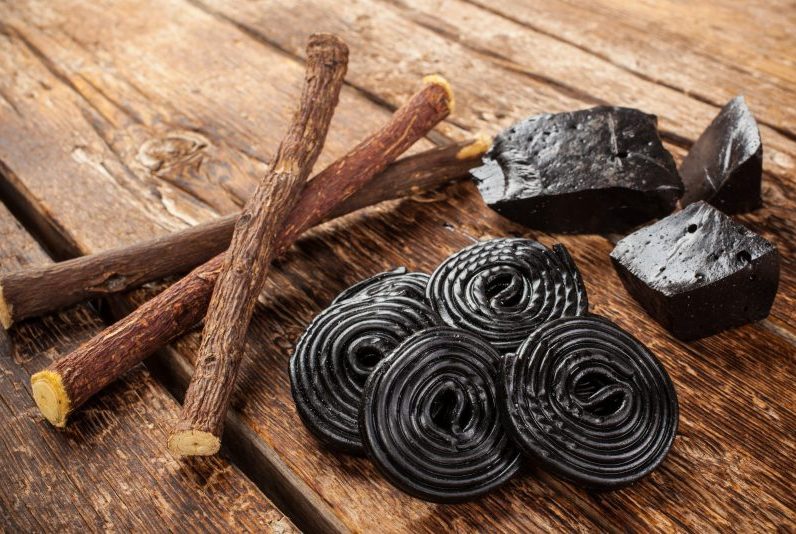Did you know there’s a compound found in black licorice that can have a potent effect on your electrolyte levels? This compound actually has therapeutic applications when used correctly, but too much of it can have a dire effect. It can cause severe electrolyte imbalances even leading to death in extreme cases. In fact, black licorice risks are valid, especially if you eat a lot of the candy or consume black licorice extract in supplements or other foods.
Health experts are now calling for better public knowledge of black licorice risks. Sadly, a death was recently reported from the ingestion of too much black licorice candy. How could this happen?
Since most people know very little about the glycyrrhizic acid found in black licorice and its risks, it’s important to get the word out. Especially if you’re a black licorice lover, here’s what you need to know about this compound, it’s content in commercial black licorice and supplements, and its effect on health.
How is Death from Black Licorice Possible?
Black licorice contains a potent compound called glycyrrhizic acid. This acid is often touted for its therapeutic benefits including potentially supporting liver health, reduced inflammatory effects, reduced oxidative stress, and more. However, the dark side of glycyrrhizic acid is its effect on electrolyte balance. It’s this imbalance that makes over-consumption of black licorice risky.
Electrolytes are extremely important to heart function, and the body works very hard to maintain balance. When glycyrrhizic acid accumulates in the body from black licorice extract, sodium rises and potassium drops in the blood plasma. This can lead to dangerously low blood pressure and rarely, death.
The recent report of a death from black licorice states the Massachusettes man ate about 1.5 bags of black licorice every day for a few weeks. This amount was enough to dramatically alter his electrolytes and cause his heart to stop.
Unfortunately, many people don’t know about black licorice risks, whether from candy, supplements, or additives.
Glycyrrhizic Acid in Food and Supplements
Currently, the Food and Drug Administration (FDA) has deemed licorice root to be generally recognized as safe for use in foods (1). The FDA allows up to 3.1% glycyrrhizic acid within the food’s content, but this amount is not always regulated or disclosed. In a statement, the FDA has now warned that eating 2 ounces of black licorice per day for 2 or more weeks could cause an irregular heart rhythm or arrhythmia in those over 40 years of age.
Glycyrrhizic acid is extracted from Glycyrrhiza glabra, the root of the licorice plant (2). Interestingly, it has been developed in Japan and China as a drug to support liver health. In addition, it is used in many foods and supplements as a sweetener. It can be found in jelly beans, licorice teas, supplements, and even Belgian beers.
In supplemental form, glycyrrhizic acid may be found as a powder, softgel, tincture, etc. While there’s no standardized dose for glycyrrhizic acid or black licorice extract, the World Health Organization (WHO) and European Scientific Committee of Food (SCF) both recommend limiting glycyrrhizic acid intake to no more than 100 mg per day (3). Some candies, supplements, foods, and drinks may contain more than this limit.
Valid Black Licorice Risks
Black licorice risks can come from both chronic consumption of the extract, or very large doses over a shorter period of time. Once elevated in the body, glycyrrhizic acid can cause an abnormal and significant increase in cortisol, which can lead to altered sodium and potassium levels (4). Then, this imbalance may result in (5):
- elevated or very low blood pressure
- muscle weakness
- abnormal heart rhythms
- kidney illness
- heart conditions
- fluid in the lungs
While it’s very rare that black licorice extract would lead to death, doctors are urging the FDA to take a closer look at glycyrrhizic acid levels in foods and supplements after this recent tragedy. What’s more, black licorice risks are much higher for those who already have known heart or electrolyte conditions, and for anyone over 40 years of age.
It’s important for the public to know about the risks as more people use supplements without medical advice. Despite its benefits experts warn that the daily consumption of licorice extract is not justified as black licorice risks outweigh any benefits (6).
Other Risks of Candy
Of course, there are other risks associated with eating candy, that are much more common. These risks include tooth decay, blood sugar alterations, weight gain, energy peaks and valleys, inflammatory actions, and more. Omitting processed candy and sugar in the diet is typically very beneficial for health.
Bottom Line
Although black licorice risks are very rare, it’s still good to be aware of them especially if you eat the candy, supplements, or foods that utilize the extract. If you choose to consume or supplement with black licorice extract, make sure to discuss it with your own health care professional. While many compounds may be considered safe in our food supply, the more you know what’s your food and how it might affect you, the better prepared you are to take control of your own health.
If you’re ready to reset your food intake and cleanse your body from any compound that may be accumulating and causing disruptions to your well-being, try Dr. Colbert’s 21 Day Detox and Fast. It’s an extremely effective way to know your foods and limit any toxins. You can get started today!

















